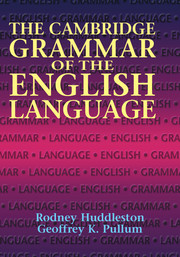Book contents
- Frontmatter
- Contents
- List of contributors
- Notational conventions
- Tree diagrams
- Preface
- 1 Preliminaries
- 2 Syntactic overview
- 3 The verb
- 4 The clause: complements
- 5 Nouns and noun phrases
- 6 Adjectives and adverbs
- 7 Prepositions and preposition phrases
- 8 The clause: adjuncts
- 9 Negation
- 10 Clause type and illocutionary force
- 11 Content clauses and reported speech
- 12 Relative constructions and unbounded dependencies
- 13 Comparative constructions
- 14 Non-finite and verbless clauses
- 15 Coordination and supplementation
- 16 Information packaging
- 17 Deixis and anaphora
- 18 Inflectional morphology and related matters
- 19 Lexical word-formation
- 20 Punctuation
- Further reading
- Index
- Lexical index
- Conceptual index
7 - Prepositions and preposition phrases
Published online by Cambridge University Press: 26 May 2017
- Frontmatter
- Contents
- List of contributors
- Notational conventions
- Tree diagrams
- Preface
- 1 Preliminaries
- 2 Syntactic overview
- 3 The verb
- 4 The clause: complements
- 5 Nouns and noun phrases
- 6 Adjectives and adverbs
- 7 Prepositions and preposition phrases
- 8 The clause: adjuncts
- 9 Negation
- 10 Clause type and illocutionary force
- 11 Content clauses and reported speech
- 12 Relative constructions and unbounded dependencies
- 13 Comparative constructions
- 14 Non-finite and verbless clauses
- 15 Coordination and supplementation
- 16 Information packaging
- 17 Deixis and anaphora
- 18 Inflectional morphology and related matters
- 19 Lexical word-formation
- 20 Punctuation
- Further reading
- Index
- Lexical index
- Conceptual index
Summary
The category of prepositions
This book employs a definition of the category of prepositions that is considerably broader than those used in traditional grammars of English. The purpose of this section is to give an overview of the items that are assigned to the category of prepositions under our analysis.
◼ Traditional definition
The general definition of a preposition in traditional grammar is that it is a word that governs, and normally precedes, a noun or pronoun and which expresses the latter's relation to another word. ‘Govern’ here indicates that the preposition determines the case of the noun or pronoun (in some languages, certain prepositions govern an accusative, others a dative, and so on). In English, those pronouns that have different (non-genitive) case forms almost invariably appear in the accusative after prepositions, so the issue of case government is of less importance, and many definitions omit it.
In our framework we substitute ‘noun phrase’ for the traditional ‘noun or pronoun’. With that modification, the traditional definition can be illustrated by such examples as the following, where the preposition is underlined.
[1] i Max sent a photograph of his new house to his parents.
ii They are both very keen on golf.
In [i] the preposition of relates the NP his new house to the noun photograph (we understand that the new house is depicted in the photograph), while to relates the NP his parents to the verb send (we understand his parents to have been the recipients of the photograph). Similarly, in [ii] on relates the NP golf to the adjective keen (the semantic relation is like that between direct object and verb in They both very much like golf : the semantic role associated with golf is that of stimulus for the emotional feeling).
◼ Prepositions as heads
In this book, in keeping with much work in modern linguistics, we adopt a significantly different conception of prepositions. We take them to be heads of phrases – phrases comparable to those headed by verbs, nouns, adjectives, and adverbs, and containing dependents of many different sorts. This change in conception leads to a considerable increase in the set of words that are assigned to the category of prepositions.
- Type
- Chapter
- Information
- The Cambridge Grammar of the English Language , pp. 597 - 662Publisher: Cambridge University PressPrint publication year: 2002
- 47
- Cited by

